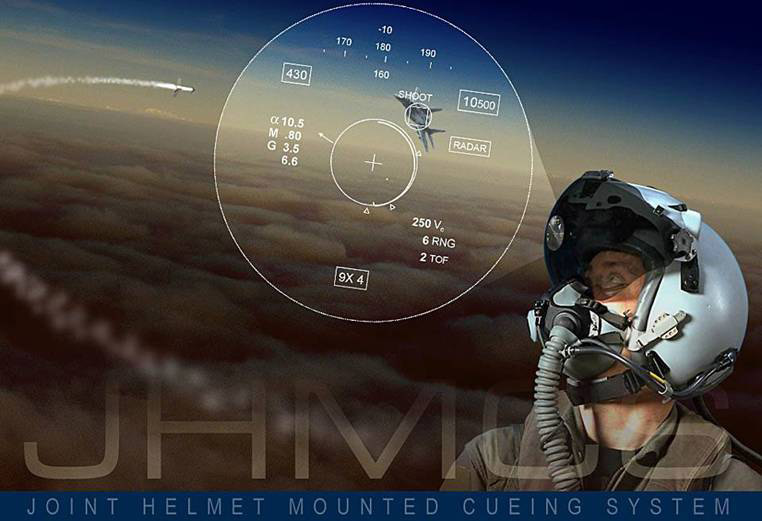Fighter Jet News
F-16 Fighting Falcon News
Wolf Pack AFE techs upgrade pilot equipment
November 4, 2007 (by
SSgt. Araceli Alarcon) -
Technicians from the 80th Fighter Squadron Aircrew Flight Equipment (AFE) received training from Boeing experts on the Joint Helmet Mounted Cueing System (JHMCS) from Oct. 29 to Nov. 1.

"The purpose is to train Aircrew Flight Equipment (AFE) technicians on the sizing, fitting, inspection and maintenance of the JHMCS helmet and related sub-systems," said Master Sgt Eric Seney, 80th Fighter Squadron AFE flight chief.
The training was part of the F-16 block 40 Common Configuration Implementation Program (CCIP) upgrade currently underway. The training from Boeing consisted of how to create a custom helmet for a pilot. In order to create the helmet, the pilot must be measured for correct size. After finding the correct helmet size the visor is fitted to the pilot's head, by cutting and filing down the visor until it fits correctly. The process can take up to four hours to accomplish.
"The goal is for the visor to sit on the mask without any light leakage between them." Sergeant Seney said. "During this process a tester is connected which configures and aligns the display unit as they adjust the visor."
The new JHMCS helmets are designed with an integrated heads-up display (HUD). Critical data such as airspeed, altitude and target range is projected directly on to the pilot's visor. This will help reduce tasks required by pilots, such as checking the display and readout in the cockpit.
According to a Boeing statement, "there are no helmet-mounted displays or cueing systems currently deployed on U.S. Air Force or Navy fighter aircraft. Current aircraft fire control systems rely primarily upon on-board aircraft radar and heads-up display to acquire and track airborne targets. These systems present weapons employment deficiencies within the visual range arena due to limited 'head out' target acquisition capabilities and restrictive visual verification field of regard."
The JHMCS visor display also acts as a targeting device. The visor display can aim weapons sensors wherever the pilot is looking. This system will also minimize maneuvering of the aircraft and help reduce time spent in a hostile environment.
"It increases our capabilities in all aspects of our mission whether it's air-to-air or air-to-ground operations", said Capt Darin Wetzler 80th Fighter squadron pilot. "It allows us to use the full capacity of our weapons."
"The JHMCS consists of a 20 percent field of view" said Staff Sergeant Kishawn Thibou 80th FS aircrew flight equipment technician "Which means if they can see a target even if a target is not in front of them they will be able to lock on to it"
Sergeant Thibou said the 80th Fighter Squadron is the first U.S. squadron on the Peninsula to use this system which will improve the Wolf Packs fighting and tactical capabilities.

The JHMCS provides Air Force aircraft the capability to cue and verify on-board weapons and weapons sensors to a specific azimuth/elevation determined by the pilot's head position and to confirm sensor line-of-sight. The intent is to reduce tasks required of pilots, verify seeker/sensor position, and ensure a first shot opportunity. [Illustration provided by Boeing]
The training was part of the F-16 block 40 Common Configuration Implementation Program (CCIP) upgrade currently underway. The training from Boeing consisted of how to create a custom helmet for a pilot. In order to create the helmet, the pilot must be measured for correct size. After finding the correct helmet size the visor is fitted to the pilot's head, by cutting and filing down the visor until it fits correctly. The process can take up to four hours to accomplish.
"The goal is for the visor to sit on the mask without any light leakage between them." Sergeant Seney said. "During this process a tester is connected which configures and aligns the display unit as they adjust the visor."
The new JHMCS helmets are designed with an integrated heads-up display (HUD). Critical data such as airspeed, altitude and target range is projected directly on to the pilot's visor. This will help reduce tasks required by pilots, such as checking the display and readout in the cockpit.
According to a Boeing statement, "there are no helmet-mounted displays or cueing systems currently deployed on U.S. Air Force or Navy fighter aircraft. Current aircraft fire control systems rely primarily upon on-board aircraft radar and heads-up display to acquire and track airborne targets. These systems present weapons employment deficiencies within the visual range arena due to limited 'head out' target acquisition capabilities and restrictive visual verification field of regard."
The JHMCS visor display also acts as a targeting device. The visor display can aim weapons sensors wherever the pilot is looking. This system will also minimize maneuvering of the aircraft and help reduce time spent in a hostile environment.
"It increases our capabilities in all aspects of our mission whether it's air-to-air or air-to-ground operations", said Capt Darin Wetzler 80th Fighter squadron pilot. "It allows us to use the full capacity of our weapons."
"The JHMCS consists of a 20 percent field of view" said Staff Sergeant Kishawn Thibou 80th FS aircrew flight equipment technician "Which means if they can see a target even if a target is not in front of them they will be able to lock on to it"
Sergeant Thibou said the 80th Fighter Squadron is the first U.S. squadron on the Peninsula to use this system which will improve the Wolf Packs fighting and tactical capabilities.
Courtesy 8th Fighter Wing Public Affairs
Related articles:
Forum discussion:
Tags
- 4th FS to deploy with new combat capabilities (2007-08-02)
- 18th FS 'Blue Foxes' receive JHMCS helmets (2007-03-03)
- Boeing to produce Joint Helmet-Mounted Cueing Systems for F-16s (2003-09-01)
- Boeing gets $10.4 Million Helmet Mounted Cueing System contract (2000-08-22)
- F-16 Fighting Falcon news archive
Forum discussion:
- Start a discussion about this article in the F-16.net forum.
Tags
